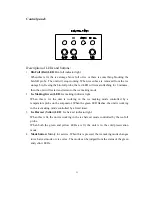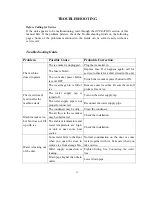
13
2.
All horizontal runs of drain lines must have a fall of ¼” per foot. An air gap will likely
be required between the ice maker drain tube and the drain/waste receptacle. A
standpipe with a trap below it would be acceptable for the drain/waste receptacle. A
floor drain is also acceptable.
3.
Pour 1 gallon of water into the ice storage bin to check for leaks in the drainage system.
Tighten any connections that leak.
IMPORTANT: This ice maker is not a freezer. Infrequent drainage will
cause a high rate of melting in the ice storage bin.
Installation Types
This ice maker has been designed for Mobile (free-standing) installation. However, it can
also be Enclosed (as under a cabinet) or Built-in (sealed to the floor). In any case, there
must be adequate air space around the unit for ventilation.
Mobile installation:
A mobile installation will allow you to install the ice maker free-standing in any place you
desire provided you have access to a water supply. You must follow the stated instructions
for
a. Electrical requirements
b. Water supply
c. Leveling the ice maker.
Enclosed Installation:
An enclosed installation will allow you to install the ice maker under a cabinet, or in a
kitchen cabinet provided the required clearance space around the ice maker is respected.
This installation has the same requirements as a mobile installation.
Built-in installation:
If this method of installation is chosen, it will still be necessary to allow adequate
ventilation space around the unit. The following additional items must be observed.
1.
Place ice maker in front of installation location. Remove the feet and place the unit flat
on the floor or on a platform depending on your installation requirements.
2.
The water supply line must be plumbed before connecting to the ice maker.
3.
Turn on main water supply and tap. Check for water supply connection leaks. Tighten
every connection (including connection at the water inlet).
4.
If the electrical outlet for the ice maker is behind the cabinet, plug in the ice maker.
5.
Push the ice maker into position.
6.
Seal all around the cabinet to the floor with an approved caulking compound.
IMPORTANT: Be sure the drain hose is connected and fed into the drain line before the
ice maker is moved into its final position.











































